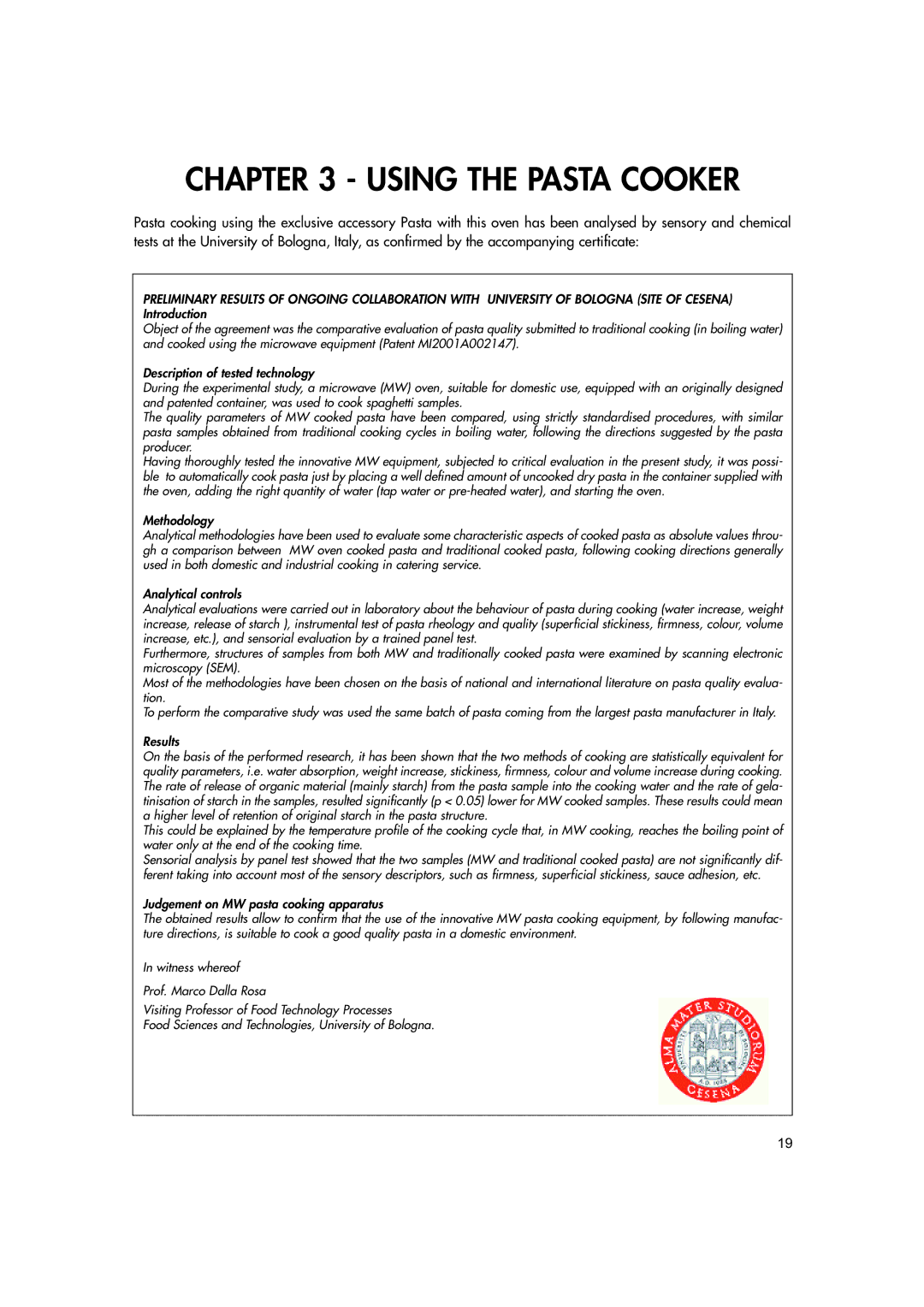
CHAPTER 3 - USING THE PASTA COOKER
Pasta cooking using the exclusive accessory Pasta with this oven has been analysed by sensory and chemical tests at the University of Bologna, Italy, as confirmed by the accompanying certificate:
PRELIMINARY RESULTS OF ONGOING COLLABORATION WITH UNIVERSITY OF BOLOGNA (SITE OF CESENA) Introduction
Object of the agreement was the comparative evaluation of pasta quality submitted to traditional cooking (in boiling water) and cooked using the microwave equipment (Patent MI2001A002147).
Description of tested technology
During the experimental study, a microwave (MW) oven, suitable for domestic use, equipped with an originally designed and patented container, was used to cook spaghetti samples.
The quality parameters of MW cooked pasta have been compared, using strictly standardised procedures, with similar pasta samples obtained from traditional cooking cycles in boiling water, following the directions suggested by the pasta producer.
Having thoroughly tested the innovative MW equipment, subjected to critical evaluation in the present study, it was possi- ble to automatically cook pasta just by placing a well defined amount of uncooked dry pasta in the container supplied with the oven, adding the right quantity of water (tap water or
Methodology
Analytical methodologies have been used to evaluate some characteristic aspects of cooked pasta as absolute values throu- gh a comparison between MW oven cooked pasta and traditional cooked pasta, following cooking directions generally used in both domestic and industrial cooking in catering service.
Analytical controls
Analytical evaluations were carried out in laboratory about the behaviour of pasta during cooking (water increase, weight increase, release of starch ), instrumental test of pasta rheology and quality (superficial stickiness, firmness, colour, volume increase, etc.), and sensorial evaluation by a trained panel test.
Furthermore, structures of samples from both MW and traditionally cooked pasta were examined by scanning electronic microscopy (SEM).
Most of the methodologies have been chosen on the basis of national and international literature on pasta quality evalua- tion.
To perform the comparative study was used the same batch of pasta coming from the largest pasta manufacturer in Italy.
Results
On the basis of the performed research, it has been shown that the two methods of cooking are statistically equivalent for quality parameters, i.e. water absorption, weight increase, stickiness, firmness, colour and volume increase during cooking. The rate of release of organic material (mainly starch) from the pasta sample into the cooking water and the rate of gela- tinisation of starch in the samples, resulted significantly (p < 0.05) lower for MW cooked samples. These results could mean a higher level of retention of original starch in the pasta structure.
This could be explained by the temperature profile of the cooking cycle that, in MW cooking, reaches the boiling point of water only at the end of the cooking time.
Sensorial analysis by panel test showed that the two samples (MW and traditional cooked pasta) are not significantly dif- ferent taking into account most of the sensory descriptors, such as firmness, superficial stickiness, sauce adhesion, etc.
Judgement on MW pasta cooking apparatus
The obtained results allow to confirm that the use of the innovative MW pasta cooking equipment, by following manufac- ture directions, is suitable to cook a good quality pasta in a domestic environment.
In witness whereof
Prof. Marco Dalla Rosa
Visiting Professor of Food Technology Processes
Food Sciences and Technologies, University of Bologna.
19
